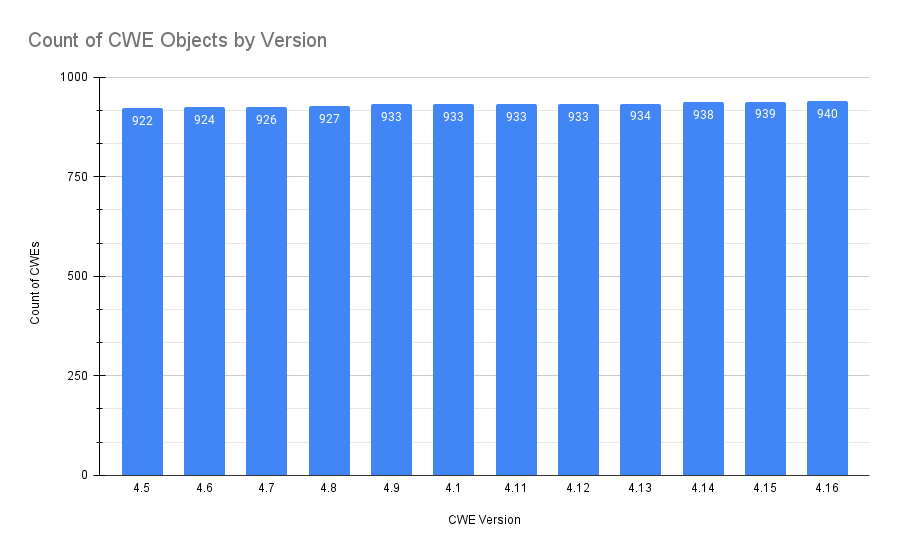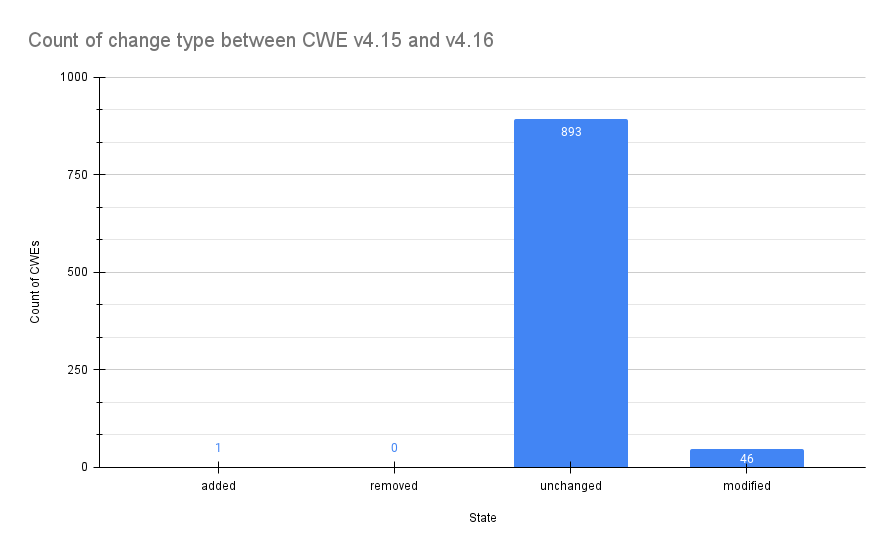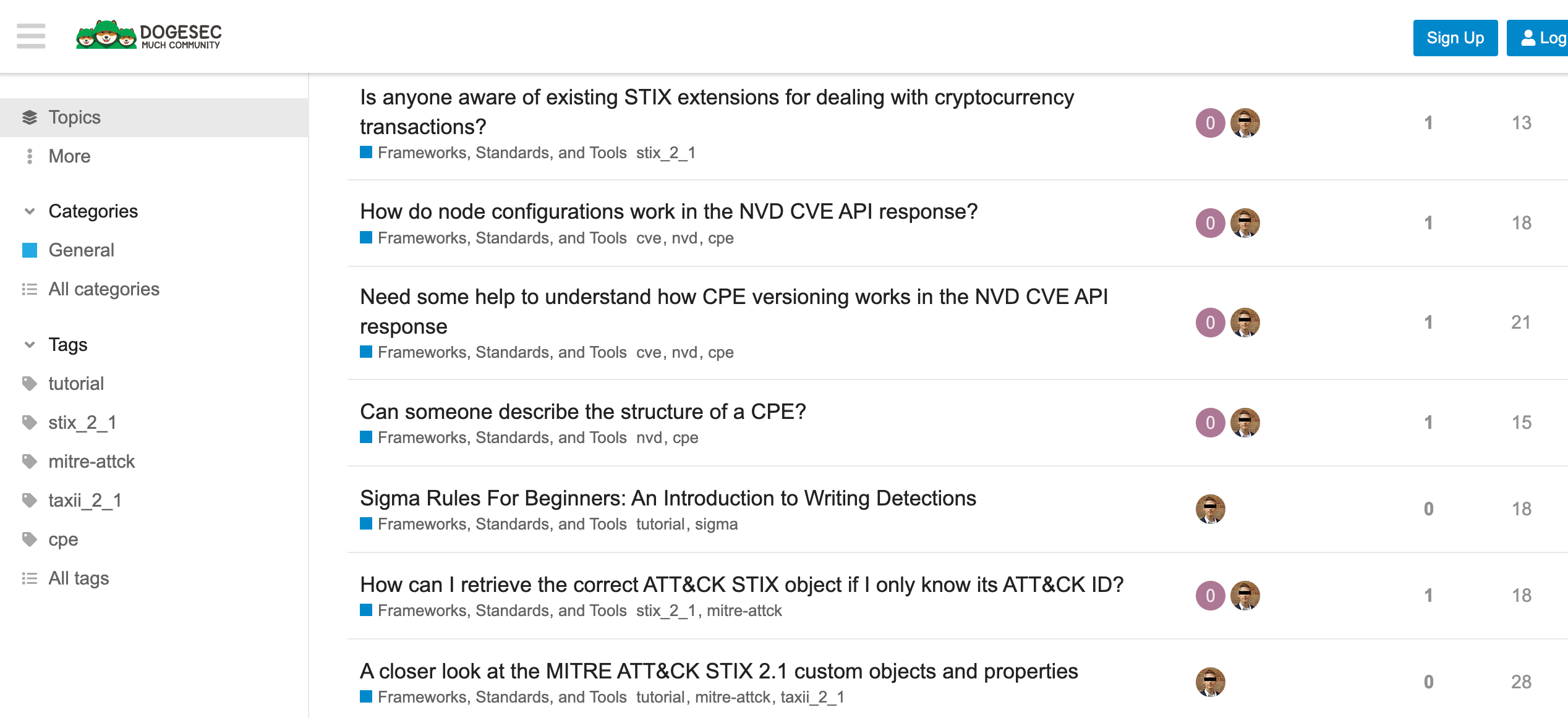If you are reading this blog post via a 3rd party source it is very likely that many parts of it will not render correctly (usually, the interactive graphs). Please view the post on dogesec.com for the full interactive viewing experience.
tl;dr
Last week saw the release of CWE v4.16. I took a deeper look into the latest release so you don’t have to.
Overview
I mostly work with CWEs (Common Weakness Enumeration) for vulnerability classification. NVD analyses each CVE submission for weaknesses. This makes it possible to search for vulnerabilities by weakness.
Our tool cwe2stix (which all the CWE data shown in this post was generated from) was created to turn all CWEs into STIX 2.1 objects so these queries between CVEs and CWEs could be run on a single intelligence graph.
As such, when I heard the new CWE Version 4.16 had been released, I was keen to take a deeper look (good news, it didn’t break any of our software!).
This post is a summary of my “deeper look”.
Follow along
In this post I am going to provide ArangoDB queries you can use to analyse and filter MITRE CWE data.
If you would like to follow along, and keep a searchable copy of CWE STIX objects locally, you can import the data using stix2arango.
Once you’ve installed stix2arango, you can run the following command to import all versions of CWE that are available at the time of writing (4.5 - 4.16)
python3 utilities/arango_cti_processor/insert_archive_cwe.py \
--database blog_demo \
--ignore_embedded_relationships
CWE (weaknesses) releases over time
To begin, here is a query that shows the addition of the CWE weaknesses over each release;
FOR doc IN mitre_cwe_vertex_collection
FILTER doc._stix2arango_note != "automatically imported on collection creation"
AND doc.type == "weakness"
AND doc.revoked != true
COLLECT note = doc._stix2arango_note WITH COUNT INTO count
LET release = SUBSTRING(note, 1) // Remove "v" prefix
SORT TO_NUMBER(SPLIT(release, ".")[0]) ASC, TO_NUMBER(SPLIT(release, ".")[1]) ASC
RETURN { release: release, count: count }

Since 4.5, 18 Weaknesses have been added.
Weakness changes in version 4.16
LET version1Docs = (
FOR doc IN mitre_cwe_vertex_collection
FILTER doc._stix2arango_note == "v4.15"
AND doc.type == "weakness"
AND doc.revoked != true
RETURN { id: doc.id, modified: doc.modified }
)
LET version2Docs = (
FOR doc IN mitre_cwe_vertex_collection
FILTER doc._stix2arango_note == "v4.16"
AND doc.type == "weakness"
AND doc.revoked != true
RETURN { id: doc.id, modified: doc.modified }
)
LET version1IDs = (FOR v IN version1Docs RETURN v.id)
LET version2IDs = (FOR v IN version2Docs RETURN v.id)
LET added = (
FOR v IN version2Docs
FILTER v.id NOT IN version1IDs
RETURN v.id
)
LET removed = (
FOR v IN version1Docs
FILTER v.id NOT IN version2IDs
RETURN v.id
)
LET unchanged = (
FOR v2 IN version2Docs
FILTER v2.id IN version1IDs
LET v1 = FIRST(FOR v1Doc IN version1Docs FILTER v1Doc.id == v2.id RETURN v1Doc)
FILTER v1.modified == v2.modified // Same ID and modified time
RETURN v2.id
)
LET modified = (
FOR v2 IN version2Docs
FILTER v2.id IN version1IDs
LET v1 = FIRST(FOR v1Doc IN version1Docs FILTER v1Doc.id == v2.id RETURN v1Doc)
FILTER v1.modified != v2.modified // Same ID but different modified time
RETURN v2.id
)
RETURN {
added: LENGTH(added),
removed: LENGTH(removed),
unchanged: LENGTH(unchanged),
modified: LENGTH(modified)
}

Between 4.15 and 4.16, 1 weakness object was added and 46 were modified.
The new weakness object in v4.16
FOR doc IN mitre_cwe_vertex_collection
FILTER doc._stix2arango_note IN ["v4.15", "v4.16"]
AND doc.type == "weakness"
AND doc.revoked != true
COLLECT id = doc.id INTO groupedDocs
LET versions = groupedDocs[*].doc
LET count_versions = LENGTH(versions)
// Only include objects that are classified as "new" (present in only one version)
FILTER count_versions == 1
// Extract external_id where source_name is "cwe"
LET cwe_id = FIRST(
FOR ref IN versions[0].external_references
FILTER ref.source_name == "cwe"
RETURN ref.external_id
)
// Return only the specified fields
RETURN {
"type": versions[0].type,
"external_id": cwe_id,
"name": versions[0].name
}
| type | external_id | name |
|---|---|---|
| weakness | CWE-1427 | Improper Neutralization of Input Used for LLM Prompting |
I expect many more AI weaknesses to be added in subsequent releases.
Changes in CWE Views
If you’re familiar with CWEs you’ll know MITRE also curate “CWE Views”.
CWE Views are perspectives on the CWE entries (weaknesses). They categorise and group weaknesses based on specific goals, domains, or analysis needs.
For example;
- Authentication Errors
- Authorization Errors
- Cryptographic Issues
In our data (created by cwe2stix), STIX grouping objects represent these views.
You can return a list of all current views as follows
FOR doc IN mitre_cwe_vertex_collection
FILTER doc._stix2arango_note == "v4.16"
AND doc.type == "grouping"
AND doc.revoked != true
RETURN doc.name
There are a total of 332 views in 4.16.
To find what Weaknesses are categorised under a View, you can use this search (this example uses the View Authentication Errors):
// Step 1: Retrieve the grouping document
LET grouping = FIRST(
FOR doc IN mitre_cwe_vertex_collection
FILTER doc._stix2arango_note == "v4.16"
AND doc.type == "grouping"
AND doc.name == "Authentication Errors"
AND doc.revoked != true
RETURN doc
)
// Step 2: Use object_refs to lookup related weaknesses
LET weaknesses = (
FOR ref IN grouping.object_refs
FOR doc IN mitre_cwe_vertex_collection
FILTER doc._stix2arango_note == "v4.16"
AND doc.revoked != true
AND doc.id == ref
// Extract external_id where source_name is "cwe"
LET external_id = FIRST(
FOR ext IN doc.external_references
FILTER ext.source_name == "cwe"
RETURN ext.external_id
)
RETURN { external_id: external_id, name: doc.name }
)
// Return the related weaknesses
RETURN weaknesses
| external_id | name |
|---|---|
| CWE-289 | Authentication Bypass by Alternate Name |
| CWE-290 | Authentication Bypass by Spoofing |
| CWE-294 | Authentication Bypass by Capture-replay |
| CWE-295 | Improper Certificate Validation |
| CWE-301 | Reflection Attack in an Authentication Protocol |
| CWE-303 | Incorrect Implementation of Authentication Algorithm |
| CWE-305 | Authentication Bypass by Primary Weakness |
| CWE-306 | Missing Authentication for Critical Function |
| CWE-307 | Improper Restriction of Excessive Authentication Attempts |
| CWE-308 | Use of Single-factor Authentication |
| CWE-309 | Use of Password System for Primary Authentication |
| CWE-322 | Key Exchange without Entity Authentication |
| CWE-603 | Use of Client-Side Authentication |
| CWE-645 | Overly Restrictive Account Lockout Mechanism |
| CWE-804 | Guessable CAPTCHA |
| CWE-836 | Use of Password Hash Instead of Password for Authentication |
This type of search is very useful when trying to identify the correct weakness to use (for example, in vulnerability classification).
Here’s what it looks like on a graph;
How this data can be used
Earlier I mentioned how CVEs can be classified with Weaknesses on analysis.
For example, CVE-2024-7593 is classified with the Weaknesses;
- CWE-287
- CWE-303
In Vulmatch all CVEs are linked to CWEs (amongst many other contextual sources). Considering CWEs only, you get an intelligence graph that looks as follows;
Now available on CTI Butler
CWE version 4.16 STIX objects (and those for all previous versions) can now be downloaded from CTI Butler.
Vulmatch
Straightforward vulnerability management. Know when software you use is vulnerable, how it is being exploited, and how to detect an attack.

CTI Butler
One API. Much CTI. CTI Butler is the API used by the world's leading cyber-security companies.

Discuss this post
Head on over to the dogesec community to discuss this post.

Never miss an update
Sign up to receive new articles in your inbox as they published.
